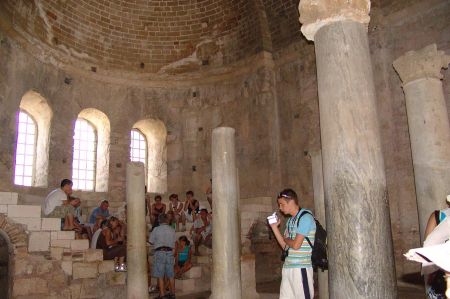Saint Nicholas of Myra - a Christian Character in Demre
- Written by Portal Editor
Each year between 4th and 6th December, the village of Demre (whose historic name is Myra), well known usually for the quality and the taste of their delicious tomatoes and oranges, faces an invasion of scientists and amateur historians.
Then a very special event takes place: The world-famous Santa Claus Symposium. Many church historians believe that the holy St. Nicholas - Santa Claus lived in Demre about 1700 years ago. His name became more and more well known as a very gracious, kind man giving presents to poor or handicapped people.
Shivering bones:
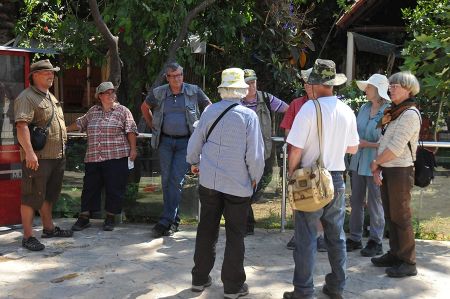 Even today, there is a lot of discussion about whether this person really existed. However, the Church accepts the stories about the Holy Santa Claus and regards him as the first Bishop of Myra.
Even today, there is a lot of discussion about whether this person really existed. However, the Church accepts the stories about the Holy Santa Claus and regards him as the first Bishop of Myra.
Skeptical people always say there was nobody like that but others have special stories about him. Once there was a small congress in Nikäa in 325 A.D. where he beat his opponent Häretiker Arius that much, it is said, that his bones were shivering. 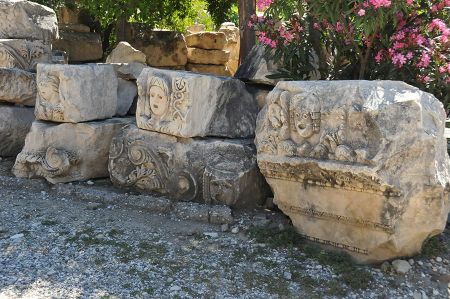 Born in the nearby town of Patara, the later Holy Santa Claus came to Myra as a young man where he became bishop. Because there was a harbor at Myra, Santa Claus was regarded as the patron saint of sailors.
Born in the nearby town of Patara, the later Holy Santa Claus came to Myra as a young man where he became bishop. Because there was a harbor at Myra, Santa Claus was regarded as the patron saint of sailors.
On one of the two major roads of Demre you will find the ruins of the former St. Nicholas Church where he was said to pray. This church is seen as a holy place for both Christian and Muslim people. Turkish people call him Noel Baba, which means Father Christmas.
Pirates took away his bones
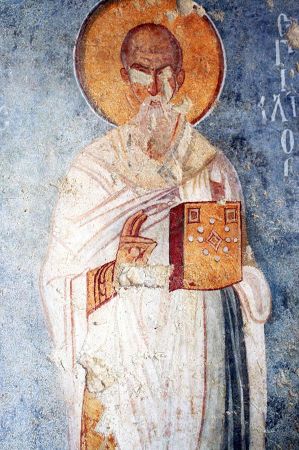 His marble sarcophagus is still in the church, but his bones were taken away by pirates coming from Bari on the Italian coast, where they buried them in a Christian church which now bears the name Santa Claus Church.
His marble sarcophagus is still in the church, but his bones were taken away by pirates coming from Bari on the Italian coast, where they buried them in a Christian church which now bears the name Santa Claus Church.
Turkish historians always say that this is not true and that a lot of the bones of this holy person have been saved and are identical with the ones now to be seen in the Museum of Antalya, an idea lot of western historians do not accept.
As he became more and more well known all over Europe, his name was connected with stories from the North about caribou, elves, toys, sledges and clothes made from animal skin.
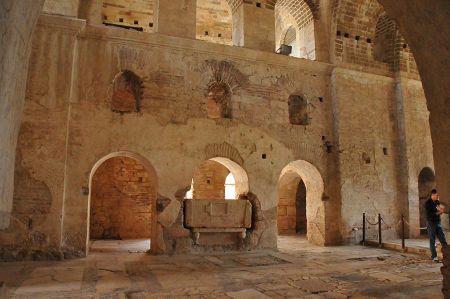 The Santa Claus of today, who brings presents to children at Christmas, is a combination of all these stories together.
The Santa Claus of today, who brings presents to children at Christmas, is a combination of all these stories together.
Other stories told are: He once gave a sack of gold to each of the daughters of a poor man as endowments to prevent them from becoming prostitutes.
Another story is about some workers: Three really young, hungry men came to Myra for work and food. An evil butcher cut them into pieces to sell them as mincemeat. When Santa Claus heard about this, he immediately went to the butcher and turned the three boys back into human beings.
God-like nature
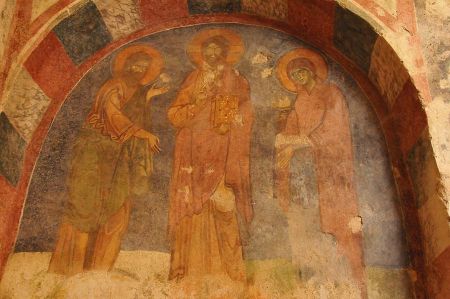 In numerous tales holy people are said to rescue ship-wrecked sailors, bring dead people back to life, parted river waters like Moses did, or returned goods or property which had been stolen by gangsters. St. Nicholas would have protected Myra against famine because he organized ships full of corn to come to Myra just in time.
In numerous tales holy people are said to rescue ship-wrecked sailors, bring dead people back to life, parted river waters like Moses did, or returned goods or property which had been stolen by gangsters. St. Nicholas would have protected Myra against famine because he organized ships full of corn to come to Myra just in time.
Another story says that, as he was inspecting a church under construction, the building collapsed but he was not injured.
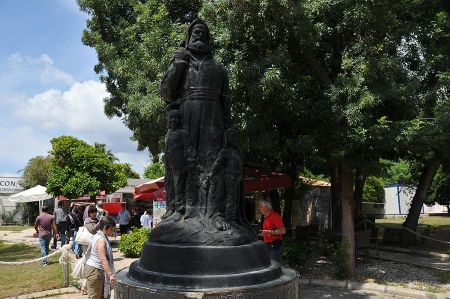 At a symposium lasting three days, which was organized by orthodox churches in the USA and the Orion Tourism, a Turkish travel agency, scientists and church people discussed the character and the life of this holy man and also studied his development as a Christian.
At a symposium lasting three days, which was organized by orthodox churches in the USA and the Orion Tourism, a Turkish travel agency, scientists and church people discussed the character and the life of this holy man and also studied his development as a Christian.
On 6th of December, the day of the death of Santa Claus, priests pray in the small church of St. Nicholas and there is also a big festival held in Demre.
Today´s tradition
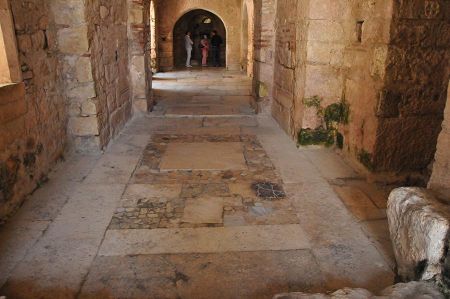 Saint Nicholas of Myra (* between 270 and 286 in Patara, December 6, 326, 345, 351 or 365) is one of the most famous saints of the Eastern Churches and the Latin Church. His feast day, the 6th of December, is celebrated throughout Christianity with numerous folk customs.
Saint Nicholas of Myra (* between 270 and 286 in Patara, December 6, 326, 345, 351 or 365) is one of the most famous saints of the Eastern Churches and the Latin Church. His feast day, the 6th of December, is celebrated throughout Christianity with numerous folk customs.
The modern Santa Claus grew out of traditions surrounding the historical Saint Nicholas, a fourth-century Greek bishop and gift-giver of Myra, the British figure of Father Christmas, the Dutch figure of Sinterklaas (himself based on Saint Nicholas), the German figure of the Christkind (a fabulized Christ Child), and the holidays of Twelfth Night and Epiphany and their associated figures of the Three Kings (based on the gift-giving Magi of the Nativity) and Befana.
Please read as well:
Xanthus - Capital town of Lycia explained by Wolfgang Dorn
Aspendos - ancient Roman Theatre
-
 Myra & Demre - Saint Nicholas
Myra & Demre - Saint Nicholas
Myra & Demre - Saint Nicholas
Myra & Demre - Saint Nicholas
-
 Myra & Demre - Saint Nicholas
Myra & Demre - Saint Nicholas
Myra & Demre - Saint Nicholas
Myra & Demre - Saint Nicholas
-
 Myra & Demre - Saint Nicholas
Myra & Demre - Saint Nicholas
Myra & Demre - Saint Nicholas
Myra & Demre - Saint Nicholas
-
 Myra & Demre - Saint Nicholas
Myra & Demre - Saint Nicholas
Myra & Demre - Saint Nicholas
Myra & Demre - Saint Nicholas
-
 Myra & Demre - Saint Nicholas
Myra & Demre - Saint Nicholas
Myra & Demre - Saint Nicholas
Myra & Demre - Saint Nicholas
-
 Myra & Demre - Saint Nicholas
Myra & Demre - Saint Nicholas
Myra & Demre - Saint Nicholas
Myra & Demre - Saint Nicholas
-
 Myra & Demre - Saint Nicholas
Myra & Demre - Saint Nicholas
Myra & Demre - Saint Nicholas
Myra & Demre - Saint Nicholas
-
 Myra & Demre - Saint Nicholas
Myra & Demre - Saint Nicholas
Myra & Demre - Saint Nicholas
Myra & Demre - Saint Nicholas
-
 Myra & Demre - Saint Nicholas
Myra & Demre - Saint Nicholas
Myra & Demre - Saint Nicholas
Myra & Demre - Saint Nicholas
-
 Myra & Demre - Saint Nicholas
Myra & Demre - Saint Nicholas
Myra & Demre - Saint Nicholas
Myra & Demre - Saint Nicholas
-
 Myra & Demre - Saint Nicholas
Myra & Demre - Saint Nicholas
Myra & Demre - Saint Nicholas
Myra & Demre - Saint Nicholas
-
 Myra & Demre - Saint Nicholas
Myra & Demre - Saint Nicholas
Myra & Demre - Saint Nicholas
Myra & Demre - Saint Nicholas
-
 Myra & Demre - Saint Nicholas
Myra & Demre - Saint Nicholas
Myra & Demre - Saint Nicholas
Myra & Demre - Saint Nicholas
-
 Myra & Demre - Saint Nicholas
Myra & Demre - Saint Nicholas
Myra & Demre - Saint Nicholas
Myra & Demre - Saint Nicholas
-
 Myra & Demre - Saint Nicholas
Myra & Demre - Saint Nicholas
Myra & Demre - Saint Nicholas
Myra & Demre - Saint Nicholas
-
 Myra & Demre - Saint Nicholas
Myra & Demre - Saint Nicholas
Myra & Demre - Saint Nicholas
Myra & Demre - Saint Nicholas
-
 Myra & Demre - Saint Nicholas
Myra & Demre - Saint Nicholas
Myra & Demre - Saint Nicholas
Myra & Demre - Saint Nicholas
-
 Myra & Demre - Saint Nicholas
Myra & Demre - Saint Nicholas
Myra & Demre - Saint Nicholas
Myra & Demre - Saint Nicholas
-
 Myra & Demre - Saint Nicholas
Myra & Demre - Saint Nicholas
Myra & Demre - Saint Nicholas
Myra & Demre - Saint Nicholas
-
 Myra & Demre - Saint Nicholas
Myra & Demre - Saint Nicholas
Myra & Demre - Saint Nicholas
Myra & Demre - Saint Nicholas
-
 Myra & Demre - Saint Nicholas
Myra & Demre - Saint Nicholas
Myra & Demre - Saint Nicholas
Myra & Demre - Saint Nicholas
https://www.alaturka.info/en/turkey-country/riviera/antalya/2227-saint-nicholas-of-myra#sigProIdc0037cbb62
